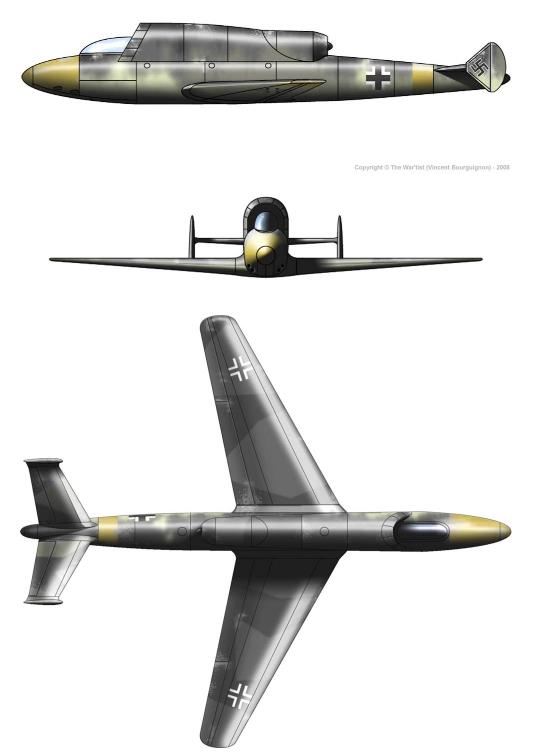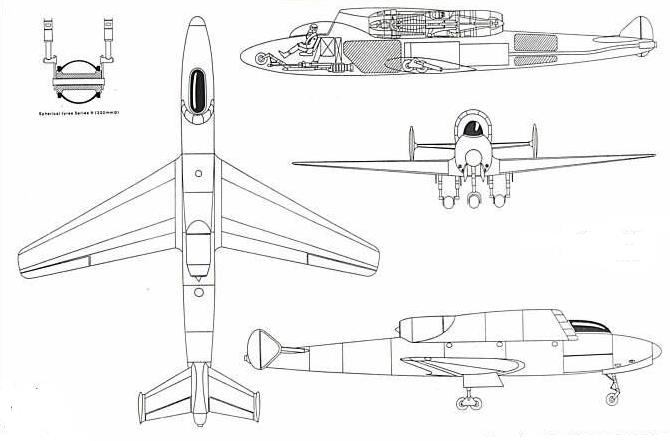| Type | Single seat fightere |
| Engine | 1 Heinkel He S 011 + 1 Walter HWK 509A |
| Dimensions | Length 11,75 m, height 2,80 m , span 10,3 m , wing area 19,0 m2 , |
| Weights | Empty , loaded , max. take off weight 6670 kg |
| Performance | Max.. speed 929 km/h, cruising speed , range 1200 km, endurance , service ceiling 18800 m , climb |
| Armament | 2 15 mm MG 151/15 or 20 mm MG 151/20 , 1 30 mm MK 103 or 2 30 mm MK 108 |

In August 1943, the design department of Arado completed an extensive study into the future development of jet fighters. Designer Wilhelm van Nes put forward three fighter proposals: a twin-jet powered version (Arado Ar TEW 16/43-23 ), a rocket powered version (Arado Ar TEW 16/43-13 ) and a combination jet/rocket powered version, the Arado Ar TEW 16/43-15.
This project (dating from March 20, 1943) was to be of all-metal construction, with a fuselage similar to the previous project's TEW 16/43-13, except it needed to be lengthened to accomodate the extra engine and fuel tanks. A single jet engine, most probably a Heinkel He S 011 developing 1300 kg (2866 lbs) of thrust, was mounted atop the fuselage immediately behind the cockpit. To improve the climb rate and performance above 10000 meters (32800 feet), a Walter HWK 509A bi-fuel rocket engine was also placed within the rear fuselage, along with the T-Stoff and C-Stoff tanks. The wings were swept back at 25 degrees, and were mounted low on the fuselage. Because of the jet engine's placement, a twin fin and rudder arrangement was chosen. Because room within the fuselage was at a premium, a novel landing gear arrangement was proposed. The main wheels were replaced with small spherical wheels and placed in tandem, thus the space needed when retracted was minimal. The nose and main wheels retracted forwards. The cockpit was located in the nose of the fuselage and afforded good front vison, but vision to the rear was very poor due to the engine and intake position. Armament was to consist of two MG 151/15 15mm or MG 151/20 20mm cannon and one MK 103 30mm cannon or two MK 108 30mm cannon, all located in the forward fuselage sides.
This project was not pursued past the preliminary design stages, surely problems would have arisen from the engine's intake position. The design of a "combination" fighter (jet and rocket power) was followed after WWII, the development of afterburners for jet engines rendered the idea obsolete.
This project (dating from March 20, 1943) was to be of all-metal construction, with a fuselage similar to the previous project's TEW 16/43-13, except it needed to be lengthened to accomodate the extra engine and fuel tanks. A single jet engine, most probably a Heinkel He S 011 developing 1300 kg (2866 lbs) of thrust, was mounted atop the fuselage immediately behind the cockpit. To improve the climb rate and performance above 10000 meters (32800 feet), a Walter HWK 509A bi-fuel rocket engine was also placed within the rear fuselage, along with the T-Stoff and C-Stoff tanks. The wings were swept back at 25 degrees, and were mounted low on the fuselage. Because of the jet engine's placement, a twin fin and rudder arrangement was chosen. Because room within the fuselage was at a premium, a novel landing gear arrangement was proposed. The main wheels were replaced with small spherical wheels and placed in tandem, thus the space needed when retracted was minimal. The nose and main wheels retracted forwards. The cockpit was located in the nose of the fuselage and afforded good front vison, but vision to the rear was very poor due to the engine and intake position. Armament was to consist of two MG 151/15 15mm or MG 151/20 20mm cannon and one MK 103 30mm cannon or two MK 108 30mm cannon, all located in the forward fuselage sides.
This project was not pursued past the preliminary design stages, surely problems would have arisen from the engine's intake position. The design of a "combination" fighter (jet and rocket power) was followed after WWII, the development of afterburners for jet engines rendered the idea obsolete.








